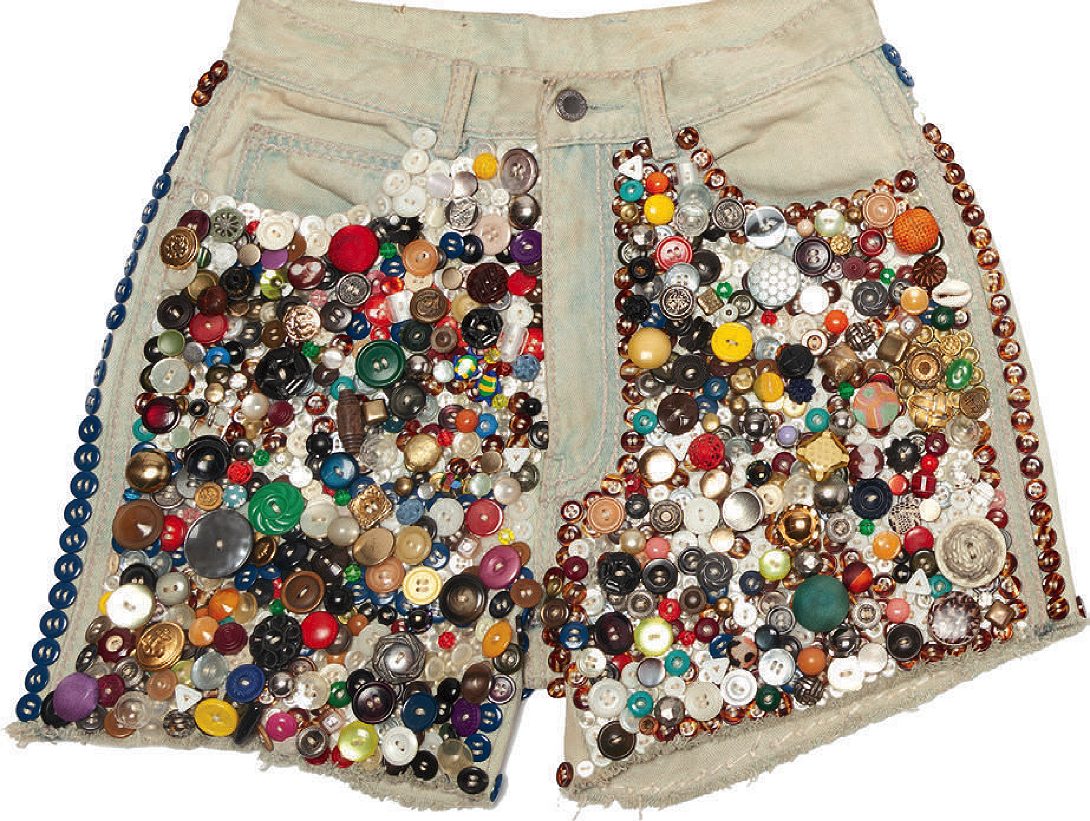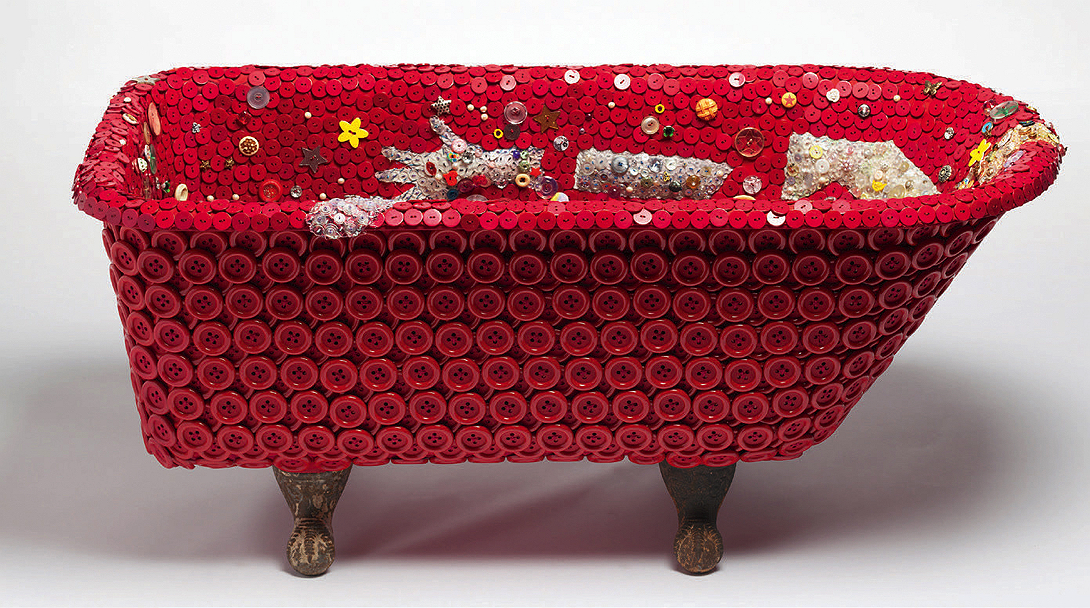Beau McCall: Buttons On! at the Fuller Craft Museum in Brockton, Massachusetts, until February 2, 2025, celebrates the artist—also known as Mr. Buttons, Count Buttons, Sir Buttons, and The Button Man. Every wearable piece, every sculpture and collage that he’s created during the last several decades pays tribute to the old-time fasteners. “I describe it like this,” he says from his Harlem studio: “What keeps the button fresh to me are the zillion billion buttons all over the world, and every time I’m working on a new project, I never know what buttons I’m going to find.”


Take his World Spinnin’ on a 45 (B-Side). The nearly three-foot replica of a 45-rpm spindle adapter (that plastic disk inside a single-song record) was hand-sewn with hundreds of yellow buttons, then topped with a hundred more shaped like peace signs, musical notes, cakes, balloons, and cocktails. Resembling the iconic smiley face, the piece was inspired by the Staple Singers’ rousing 1972 “We The People,” McCall says, and speaks to “how, wherever we are, and whatever ethnicity or skin color, music has a certain power to join us together.”
The Philadelphia native has been “making things” since he was a child watching his mother continually decorate their apartment. He took in her color schemes, patterns, and paintings. “In the 1970s, contact paper was very popular, and our entire kitchen was covered in this herringbone black-and-white checked pattern,” he notes. “I mean, she was doing things that most black people were not doing in public housing. My mother liked Picasso, but her favorite was Modigliani.” Both his parents were regal dressers and music aficionados who listened primarily to jazz—as does McCall. They had no problem with his choosing his own outfits and gravitating to art classes in school, where he learned about macramé, weaving, and tie-dyeing. “My two brothers were athletic, but I didn’t get that bug. And my parents never told me I couldn’t do what I did or I would have to go the traditional route and get a basketball or a baseball,” he says. “They just let me be me.”


In high school, after the family moved into their own home, he found his mother’s Maxwell House coffee jar full of buttons. “And it was like the buttons and me,” he says, “we were suddenly having this dialogue.” For six months, following his instincts, he painstakingly sewed buttons onto one of his mother’s sweaters. “Then I wore it out to a club, and got rave reviews. The sweater made all this noise, like I was a walking sound machine, like keys clacking, because buttons have these distinct sounds,” depending on what they bump into. That led to making other clothing integral to his burgeoning identity as a young gay man. With friends “who were people like myself,” he formed the band Strange Beauties, and began appearing as an alter ego, Jeanie Holiday, in handmade garments. By the mid-1980s McCall had moved to New York City, where he joined the Harlem Institute of Fashion and, over time, “grew into the artist I am today.” He has always fashioned button-works out of recycled textiles and clothing, but moved into making sculptures within the last two decades, gaining prominence as a meticulous craftsman who reflects on themes of iconography, pop culture, and social justice. McCall’s works are held in private and public collections, but this exhibition is the largest to date—and his first retrospective.

McCall’s partner and manager, the curator Souleo, has been instrumental in shaping McCall’s career, and is featured wearing the button art in the Brockton show’s photographs. On display, too, are jackets, vests, shorts, and even bustiers made in the 1980s and 1990s, along with more recent aprons, skirts, and sneakers. There’s a claw-foot bathtub sculpture—encrusted with glittering red buttons, along with embroidery thread and fabric—called darkmuskoilegyp-tiancrystals&floridawater/redpotionno.1 that’s inspired by Ntozake Shange’s “choreopoem” for colored girls who have considered suicide /when the rainbow is enuf. Inside the tub a supine woman is outlined, evoking her efforts to eradicate a lover’s scent and find peaceful sanctuary. Another large work from 2016, ABCDEFU, features a button-covered wooden classroom school chair beneath rulers set in the shape of a crosshair. As a boy, “I was very shy, introverted, and sort of a homebody,” McCall says, and was subjected to punishments, like having his hands and knuckles smacked with rulers by the school nuns. “I don’t think I was strong enough to handle a lot of that stuff, so I was very guarded and distrusting and very afraid of everybody and everything,” he says now. “As I got older, I was able to find a way to protect myself and also express myself—in the form of clothing.”

He describes clubbing with friends, who danced and sang while he stood around “holding everyone’s coats.” And yet, when he did finally edge away from the wall, he garnered attention as a creative soul “who always looked good and had on something that nobody else would have the nerve to wear,” he explains. “That’s where my armor came in, but it also opened up my personality and forced me to communicate.” McCall’s Button Armor Ensemble (2023) reflects this merging. The base layer, a black denim caftan, is flared into a triangle using a hidden hoop skirt over which hangs wire strung with more than 200 round buttons. The elegant piece hides and transforms the shape of its wearer, not unlike a butterfly’s eyespots.
Buttons, affordable and practical devices that have stood the test of time, simply call to him. And probably always will. “People know about me, Mr. Buttons, and they just send me their buttons,” McCall reports. People in the subway have even ripped buttons off their clothes. “It makes me feel good that I’ve been at this so long that people are beginning to pay attention to what I do, and that this everyday object speaks an artistic language that’s inspiring for other folks.”









